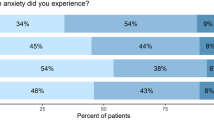Summary
Background. Discovering an intracranial aneurysm may profoundly affect the patient’s quality of life. Patients living with unruptured and untreated aneurysms often report symptoms of anxiety and depression. There are few trials studying the quality of life after treatment of unruptured intracranial aneurysms. We aimed to compare the quality of life and symptoms of anxiety or depression after endovascular coiling or open surgery clipping of unruptured intracranial aneurysms, in patients with no prior subarachnoid haemorrhage.
Method. 73 living patients were included. 44 had undergone open surgery clipping and 31 had undergone endovascular coiling within the last 5.5 years. We registered a number of parameters from medical records and the patients’ current quality of life was assessed by a questionnaire. 63 of 73 (86.3%) returned our questionnaire, which included the Norwegian version of SF-36 and the Hospital Anxiety and Depression Scale (HAD).
Findings. Many patients treated for unruptured intracranial aneurysms have a relatively low quality of life. The low scores indicate that the patients experience limitations in their ability to work or accomplish desired activities due to perceived physical or mental handicaps. There were no significant differences between the open surgery group and the endovascular group when comparing quality of life parameters after treatment. A subgroup analysis of patients with a favourable functional outcome also showed reduced quality of life without any differences in the two treatment groups. There were no signs of improvement in quality of life over time.
Conclusion. Quality of life after treatment does not seem to be a strong argument for choosing one modality of treatment over the other in patients with unruptured intracranial aneurysms. There are no significant differences in the quality of life of patients successfully treated using endovascular technique and patients who underwent craniotomy and clipping. We speculate that the low quality of life scores are due to factors unrelated to the aneurysms. The scores possibly reflect characteristics of a patient group where incidental aneurysms are more frequently diagnosed while undergoing extensive imaging procedures due to unrelated symptoms.
Similar content being viewed by others
References
GJ Rinkel M Djibuti A Algra J van Gijn (1998) ArticleTitlePrevalence and risk of rupture of intracranial aneurysms: a systematic review Stroke 29 251–256 Occurrence Handle9445359 Occurrence Handle1:STN:280:DyaK1c7gs1WgtQ%3D%3D
G Clarke AD Mendelow P Mitchell (2005) ArticleTitlePredicting the risk of rupture of intracranial aneurysms based on anatomical location Acta Neurochir (Wien) 147 259–263 Occurrence Handle1:STN:280:DC%2BD2M3osVOltw%3D%3D Occurrence Handle10.1007/s00701-004-0473-3
InstitutionalAuthorName>Unruptured intracranial aneurysms – risk of rupture and risks of surgical intervention (1998) ArticleTitleInternational study of unruptured intracranial aneurysms investigators N Engl J Med 339 1725–1733 Occurrence Handle10.1056/NEJM199812103392401
RR Vindlacheruvu AD Mendelow P Mitchell (2005) ArticleTitleRisk-benefit analysis of the treatment of unruptured intracranial aneurysms J Neurol Neurosurg Psychiatry 76 234–239 Occurrence Handle15654039 Occurrence Handle1:STN:280:DC%2BD2M%2FislSrsA%3D%3D Occurrence Handle10.1136/jnnp.2003.031930
A Molyneux R Kerr I Stratton P Sandercock M Clarke J Shrimpton R Holman (2002) ArticleTitleInternational subarachnoid aneurysm trial (ISAT) of neurosurgical clipping versus endovascular coiling in 2143 patients with ruptured intracranial aneurysms: a randomised trial Lancet 360 1267–1274 Occurrence Handle12414200 Occurrence Handle10.1016/S0140-6736(02)11314-6
AJ Molyneux RS Kerr LM Yu M Clarke M Sneade JA Yarnold P Sandercock (2005) ArticleTitleInternational subarachnoid aneurysm trial (ISAT) of neurosurgical clipping versus endovascular coiling in 2143 patients with ruptured intracranial aneurysms: a randomised comparison of effects on survival, dependency, seizures, rebleeding, subgroups, and aneurysm occlusion Lancet 366 809–817 Occurrence Handle16139655 Occurrence Handle10.1016/S0140-6736(05)67214-5
DO Wiebers JP Whisnant J Huston Suffix3rd I Meissner RD Brown SuffixJr DG Piepgras GS Forbes K Thielen D Nichols WM O’Fallon J Peacock L Jaeger NF Kassell GL Kongable-Beckman JC Torner (2003) ArticleTitleUnruptured intracranial aneurysms: natural history, clinical outcome, and risks of surgical and endovascular treatment Lancet 362 103–110 Occurrence Handle12867109 Occurrence Handle10.1016/S0140-6736(03)13860-3
EH Brilstra GJ Rinkel Y van der Graaf M Sluzewski RJ Groen RT Lo CA Tulleken (2004) ArticleTitleQuality of life after treatment of unruptured intracranial aneurysms by neurosurgical clipping or by embolisation with coils. A prospective, observational study Cerebrovasc Dis 17 44–52 Occurrence Handle14530637 Occurrence Handle10.1159/000073897
FG Barker Suffix2nd S Amin-Hanjani WE Butler CS Ogilvy BS Carter (2003) ArticleTitleIn-hospital mortality and morbidity after surgical treatment of unruptured intracranial aneurysms in the United States, 1996–2000: the effect of hospital and surgeon volume Neurosurgery 52 995–1007 Occurrence Handle12699540 Occurrence Handle10.1227/01.NEU.0000057743.56678.5F
BL Hoh JD Rabinov JC Pryor BS Carter FG Barker Suffix2nd (2003) ArticleTitleIn-hospital morbidity and mortality after endovascular treatment of unruptured intracranial aneurysms in the United States, 1996–2000: effect of hospital and physician volume AJNR Am J Neuroradiol 24 1409–1420 Occurrence Handle12917139
K Towgood JA Ogden E Mee (2005) ArticleTitlePsychosocial effects of harboring an untreated unruptured intracranial aneurysm Neurosurgery 57 858–856 Occurrence Handle16284556 Occurrence Handle10.1227/01.NEU.0000179917.47904.d8
Y Otawara K Ogasawara Y Kubo N Tomitsuka M Watanabe A Ogawa M Suzuki K Yamadate (2004) ArticleTitleAnxiety before and after surgical repair in patients with asymptomatic unruptured intracranial aneurysm Surg Neurol 62 28–31 Occurrence Handle15226063 Occurrence Handle10.1016/j.surneu.2003.07.012
JH Loge S Kaasa (1998) ArticleTitleShort form 36 (SF-36) health survey: normative data from the general Norwegian population Scand J Soc Med 26 250–258 Occurrence Handle9868748 Occurrence Handle1:STN:280:DyaK1M%2FosFKguw%3D%3D
S Saegrov (2005) ArticleTitleHealth, quality of life and cancer Int Nurs Rev 52 233–240 Occurrence Handle16033451 Occurrence Handle1:STN:280:DC%2BD2MvitFGmsA%3D%3D Occurrence Handle10.1111/j.1466-7657.2005.00416.x
J Skarstein N Aass SD Fossa E Skovlund AA Dahl (2000) ArticleTitleAnxiety and depression in cancer patients: relation between the Hospital Anxiety and Depression Scale and the European Organization for Research and Treatment of Cancer Core Quality of Life Questionnaire J Psychosom Res 49 27–34 Occurrence Handle11053601 Occurrence Handle1:STN:280:DC%2BD3M7kslOjuw%3D%3D Occurrence Handle10.1016/S0022-3999(00)00080-5
E Tuffiash RJ Tamargo AE Hillis (2003) ArticleTitleCraniotomy for treatment of unruptured aneurysms is not associated with long-term cognitive dysfunction Stroke 34 2195–2199 Occurrence Handle12907820 Occurrence Handle10.1161/01.STR.0000087787.38080.B8
Author information
Authors and Affiliations
Rights and permissions
About this article
Cite this article
Solheim, O., Eloqayli, H., Muller, T. et al. Quality of life after treatment for incidental, unruptured intracranial aneurysms. Acta Neurochir (Wien) 148, 821–830 (2006). https://doi.org/10.1007/s00701-006-0804-7
Received:
Accepted:
Published:
Issue Date:
DOI: https://doi.org/10.1007/s00701-006-0804-7




